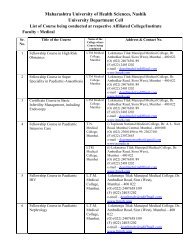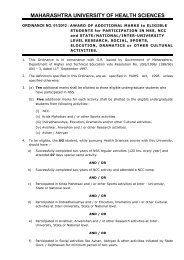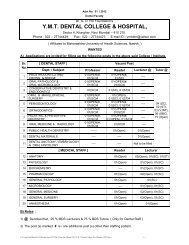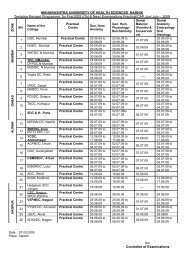Unit I
Unit I
Unit I
You also want an ePaper? Increase the reach of your titles
YUMPU automatically turns print PDFs into web optimized ePapers that Google loves.
Neuroglial cells: In H & E stain neurons and neuroglia cannot be identified separately all the time. Neuronsare supported by neuroglia in the nervous system. In their supporting role they seem to “glue” neuronstogether by being present between neuronal cell bodies and fibres holding them in places hence the name.It is important to note that the general connective tissue is present only alongthe blood vessels in the CNS.Astrocyte (Fibrous): (Gr. Astros = star) This neuroglial cell has many processes extending out in a star likefashion from its cell body and is seen better in Cajal stain. Processes are long and straight with very little orno branching. They are located in the white matter.Astrocyte (Protoplasmic): They have branching cytoplasmic processes extending from all aspects of theircell bodies. In metallic staining they resemble bushy shrubs. Their processes are shorter andbranch extensively.Processes of both the types of astrocytes widen at the end and form an astrocyte foot along the capillaries.This is the blood brain barrier. Astrocyte feet also end on the membrane that separates brain from piamatter. They play a major role in the cohesion of nervous system.Oligodendroglial cell: These cells have few tree like processes. They are responsible for the myelination inthe CNS. Their processes wrap nerve fibres to form myelin. A single cell can wrap several nerve fibres.Microglial cell: They are not true neuroglial cells but derived from general connective tissue (mesoderm).They are phagocytes derived from blood monocytes. They are also called as brain macrophages arestanied by silver carbonate method. They do not divide. Relative to the other these are the smallest glialcells with flattened body and short processes and present in more number in the grey matter.Schwann cell: They are responsible for the myelination of the peripheral nervous system. They cover theinternode region of a peripheral nerve fibre and form myelin of that internode region. Schwann cells areessential for the repair of the damaged peripheral nerves.Ependymocyte: They line the lumen of all the cavities inside the CNS viz. ventricles, aqueduct and centralcanal. According to the location they vary from squamous to columnar in shape. Their surfaces havenumerous microvilli and cilia contributing to the flow of CSF. The nucleus is heterochromatic. Tanycytesare the ependymoglial cells (ependymal astrocytes) and have the function of transport of substances betweenthe vascular system and ventricular system.Notes: 31
















